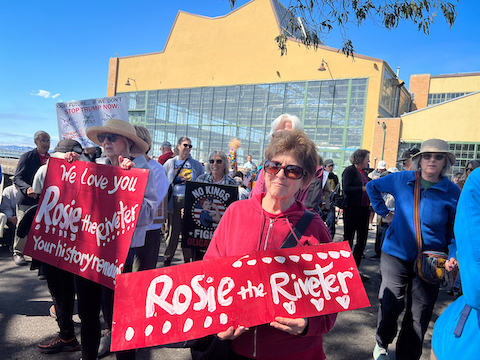
26 Aug National Parks Have Become a Battleground for American Identity

A woman holds a sign reading ‘Rosie the Riveter’ at Rosie the Riveter National Historical Park in Richmond on Monday. She was one of over a hundred celebrating the 109th anniversary of the National Park Service. The celebration also served as a protest opposing the Trump administration’s move to diminish the role of national parks as cultural historic sites presenting a multicultural public narrative. (Ruth Dusseault / Bay City News)
Story and photos by Ruth Dusseault
Bay City News
Richmond’s Rosie the Riveter WWII Home Front National Historical Park, which memorializes the experience of women Bay Area Navy shipyard workers during the war, was the home front of a cultural battle on Monday. Over a hundred people gathered to protest what they say is the Trump administration’s attack on American history.
Monday was the 109th anniversary of the National Park Service, which was hit this spring with federal funding cuts and an executive order directed at the public exhibitions in national parks.
The Rosie the Riveter Park is one of four national areas in the East Bay. The list includes the John Muir National Historic Site in Martinez, the Eugene O’Neal National Historic Site in Danville, and the Port Chicago Naval Magazine National Memorial in Concord.
“In February, anyone who was probationary, or worked less than two years, was laid off,” said Donna Graves, an independent historian who helped found Rosie the Riveter Park.
“Other people just left, because they thought this is not the park service they signed up for,” she said.
According to the National Parks Conservation Association, the Trump administration’s budget calls for cutting more than $1 billion from the National Park Service.
A March 27 executive order from the Trump administration entitled “Restoring Truth and Sanity to American History,” led the Interior Secretary Doug Burgum to instruct National Park Service staff to inventory its signage and exhibits at all 433 national park sites. All parks were required to post a notice asking visitors to identify and report “any signs or other information that are negative about either past or living Americans.”
The order specifically calls for the Secretary of Interior to:
“Take action, as appropriate and consistent with applicable law, to ensure that all public monuments, memorials, statues, markers, or similar properties within the Department of the Interior’s jurisdiction do not contain descriptions, depictions, or other content that inappropriately disparage Americans past or living (including persons living in colonial times), and instead focus on the greatness of the achievements and progress of the American people or, with respect to natural features, the beauty, abundance, and grandeur of the American landscape.”
The mandated signs have QR codes, and they have generated a few thousand comments since being posted.
“We got a glimpse into them,” said Neal Desai, senior Pacific regional director for the National Parks Conservation Association, a nonprofit that advocates for national parks. “An overwhelming majority are like, ‘Do not erase our history. Do not censor. Lay off our parks.’ ”
- Over a hundred people gather at Rosie the Riveter National Historical Park in Richmond on Monday, to celebrate the 109th anniversary of the National Park Service. Protesters also opposed the Trump administration’s move to diminish the role of national parks as cultural historic sites presenting a multicultural public narrative.
“More than two thirds of our park sites are cultural and historic sites,” said Desai.
He said the visiting public does not just like the landscapes and the wildlife.
“They like history, they like being told the truth,” Desai said. “This is not a partisan agenda. This is not a Republican or Democratic agenda. This is an extremist agenda coming to our parks.”
Donna Graves is a historian and urban planner who helped found Rosie the Riveter Park.
“This park stands in sharp contrast to the oversimplified and whitewashed version of U.S. history that the current administration is demanding from the Park Service here in Richmond,” said Graves. “As a writer, James Baldwin said, ‘American history is longer, larger, more various, more beautiful, and more terrible than anything anyone has ever said about it.'”
Contra Costa Supervisor John Gioia decried what he described as the erasure of history.
“I’m the son of a high school history teacher here in Richmond who said all parts of history are important — the good, the bad and the ugly,” he said, adding that the Rosie the Riveter Park is a place to learn about how men and women and people of all cultures work together.
“We can learn about how a shift in gender roles challenged traditional views of women’s abilities and paved the way for expanded opportunities for women after the war. We can also learn about the struggles of Black, Latino, Asian, Indigenous, disabled and others. Our parks must remain places where the real stories of our history are told and not changed for political convenience.”
“This is such a painful moment,” said Richmond City Council member Doria Robinson, referring to the Trump presidencies. “It feels like every morning you wake up to some other nonsense.”
- “If we learn only about the wins, we’ll never learn how to fight the war,” said Richmond City Council member Doria Robinson on Monday to the crowd at Rosie the Riveter National Historical Park. “We got to learn our history. You have to learn the whole thing.”
Robinson’s family moved to California during the Great Migration to find work in the factories after the war. She said national parks should be a place to face the nation’s difficult histories.
“If we learn only about the wins, we’ll never learn how to fight the war,” Robinson said. She used the example of the Selma to Montgomery National Historic Trail in Alabama, which commemorates the 54-mile route of the 1965 Voting Rights March. The trail begins at a church and crosses the Edmund Pettus Bridge in Selma, where marchers faced a brutal beating by law enforcement officers.
“We always hear about the Selma bridge,” she said, noting that the historic trail illuminates the details of the story. “You don’t hear about the many days the walk took. You don’t hear about all the different agreements they had to make with the landowners along the way because they had to camp. You don’t hear about what happened to those people who lost their land, who were victimized because they allowed the marchers to stay. You don’t hear about that. We got to learn our history. You have to learn the whole thing.”
Jonathan Jarvis, former director of the U.S. National Park Service said that during his 40 years there, their mission focused on America’s untold stories, like the experiences of Japanese Americans during WWII.
“We did it so that perhaps we will not repeat this similar kind of wartime hysteria against people just because of their ethnicity or the color of their skin,” he said.
- Flora Ninomiya speaks to a crowd gathered at the Rosie the Riveter National Historical Park in Richmond on Monday to celebrate the 109th anniversary of the National Park Service. Ninomiya’s family was forcibly removed from their Richmond home and business to Japanese-American internment camp during World War II.
Also speaking at the event was Flora Ninomiya, who was held with her family in a Japanese internment camp during World War II from the age of 7 to 10. Her father was arrested by the FBI and detained in a separate camp. She said that while the family was interned, a neighbor in Richmond watched over their nursery business and the local Mechanics Bank, where they held a mortgage, paid their property taxes while they were gone.
>>>Richmond Art Exhibit Keeps Memory of WWII Incarceration Camps Alive<<<
“We came back to California in 1945 to find our business and our home still here,” she said, thanking those who helped.
Jarvis said creation of the Stonewall National Monument in New York, which commemorates an uprising by LGBT youth against police raids, was a story that might otherwise be erased. He said it is the role of the National Park Service to protect historical and cultural landscapes.
“And do it in places where the hottest fires of our democracy have burned,” he said. “Tell those stories authentically and based on the very best scholarship.”
Copyright © 2025 Bay City News, Inc. All rights reserved. Republication, rebroadcast or redistribution without the express written consent of Bay City News, Inc. is prohibited. Bay City News is a 24/7 news service covering the greater Bay Area.


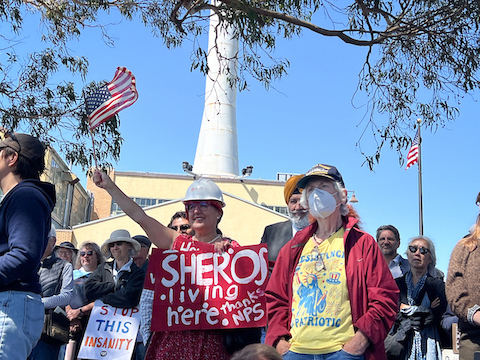
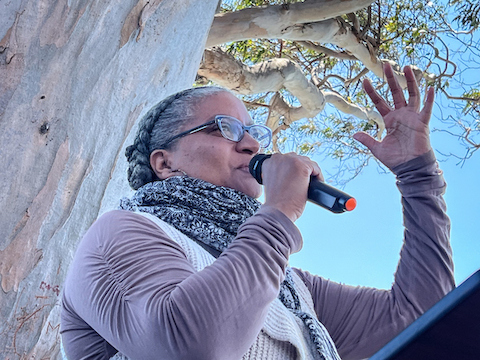
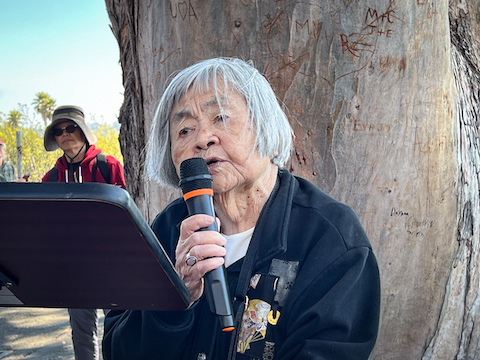

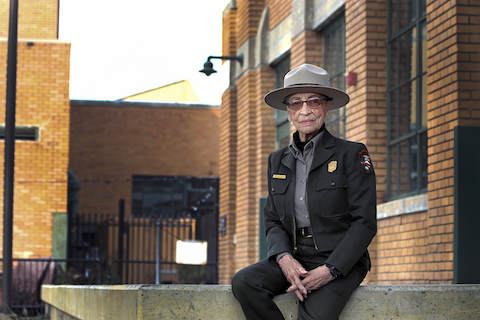
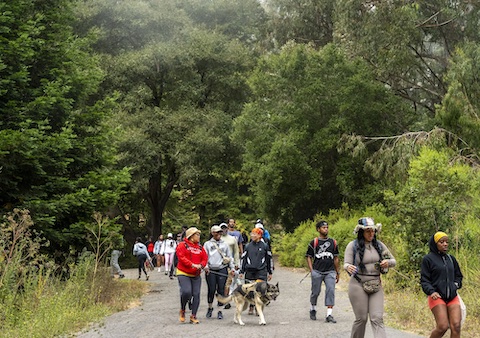
No Comments